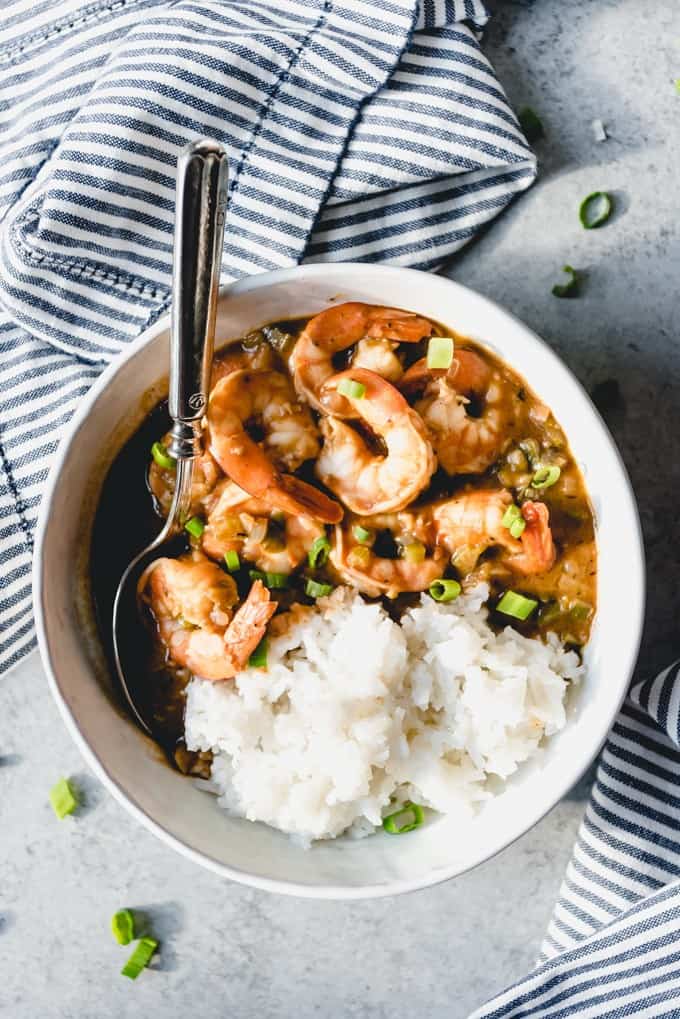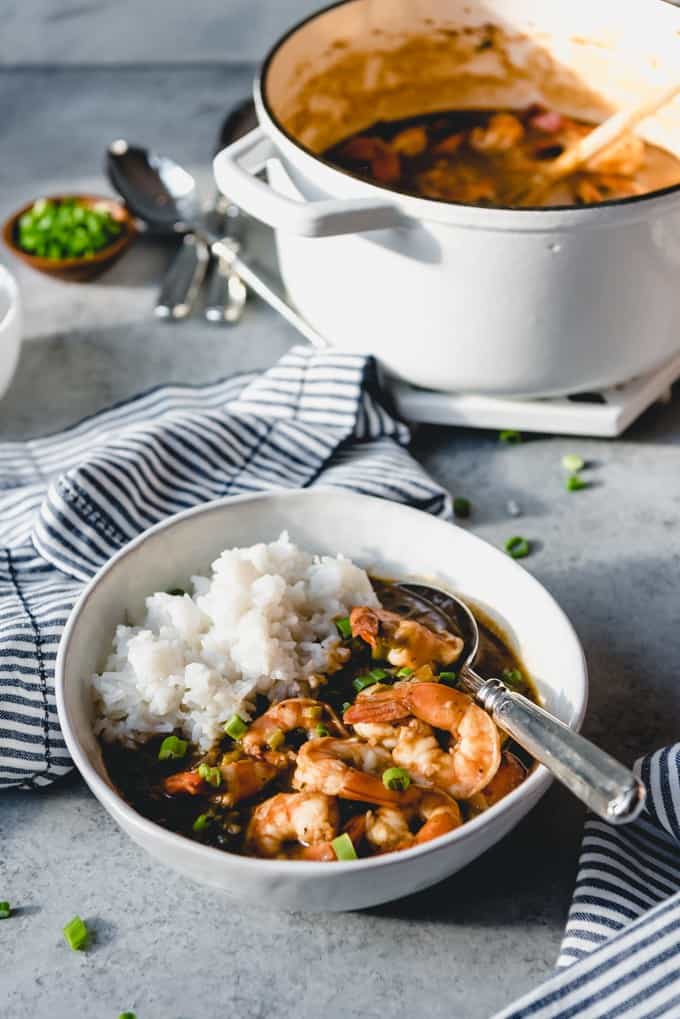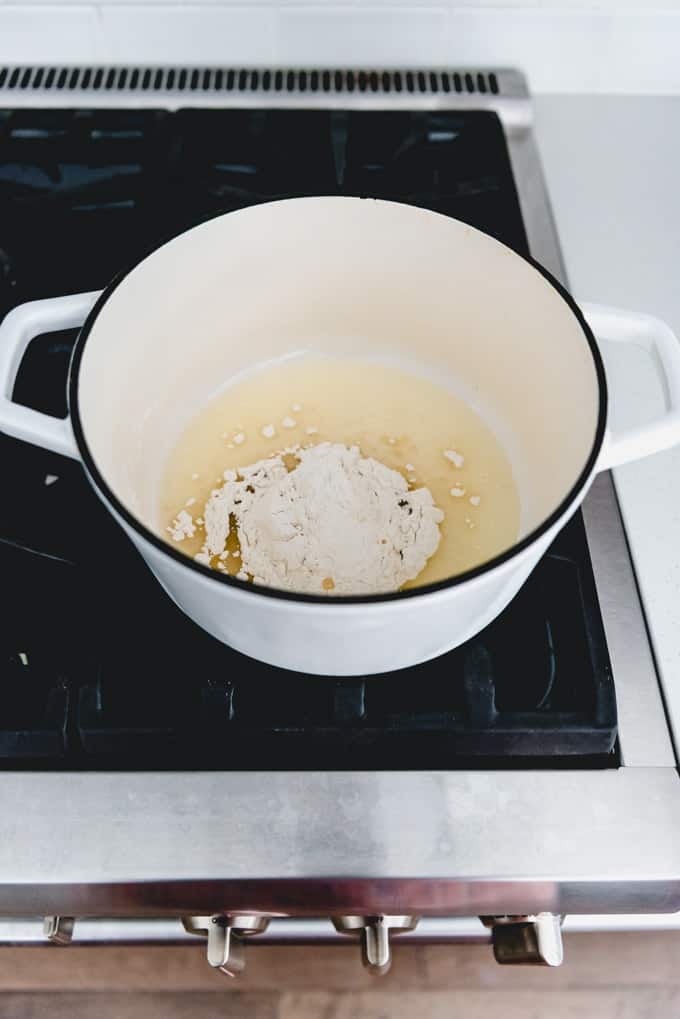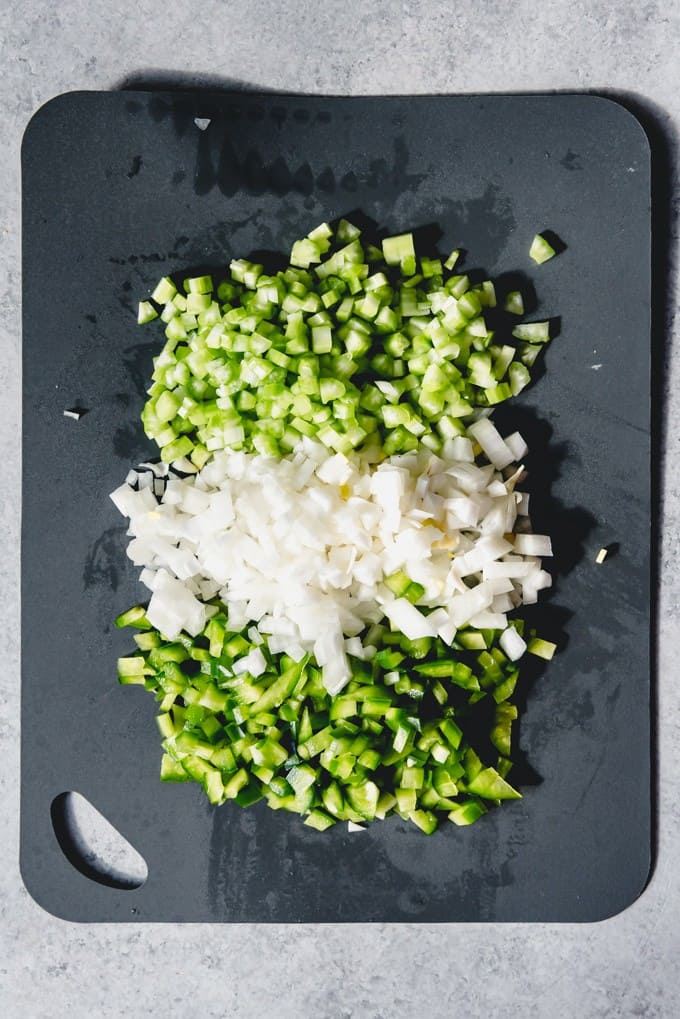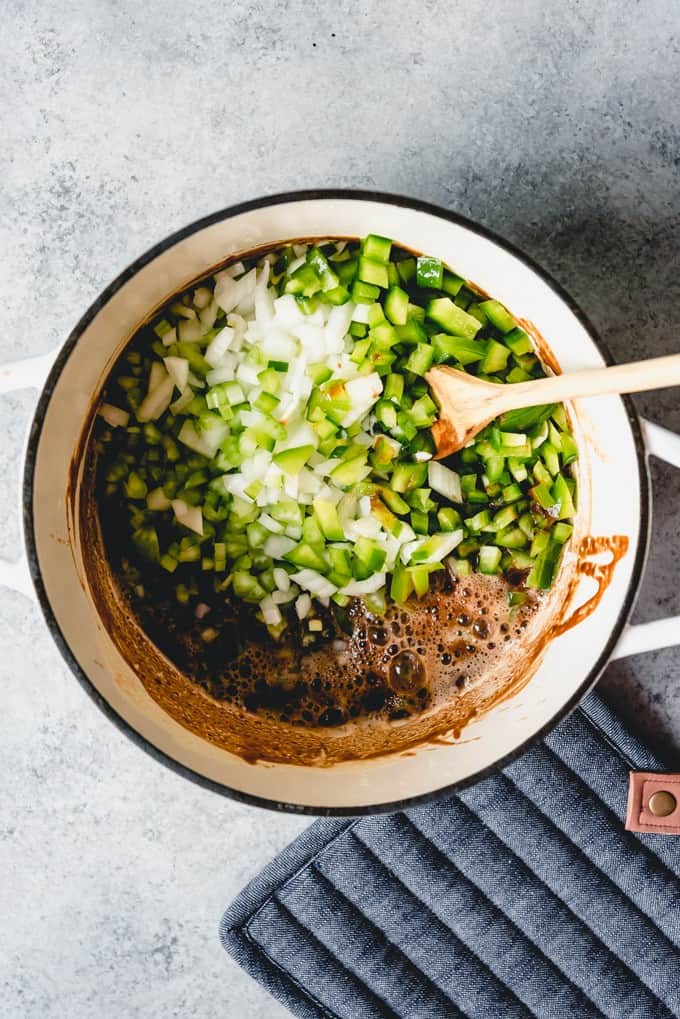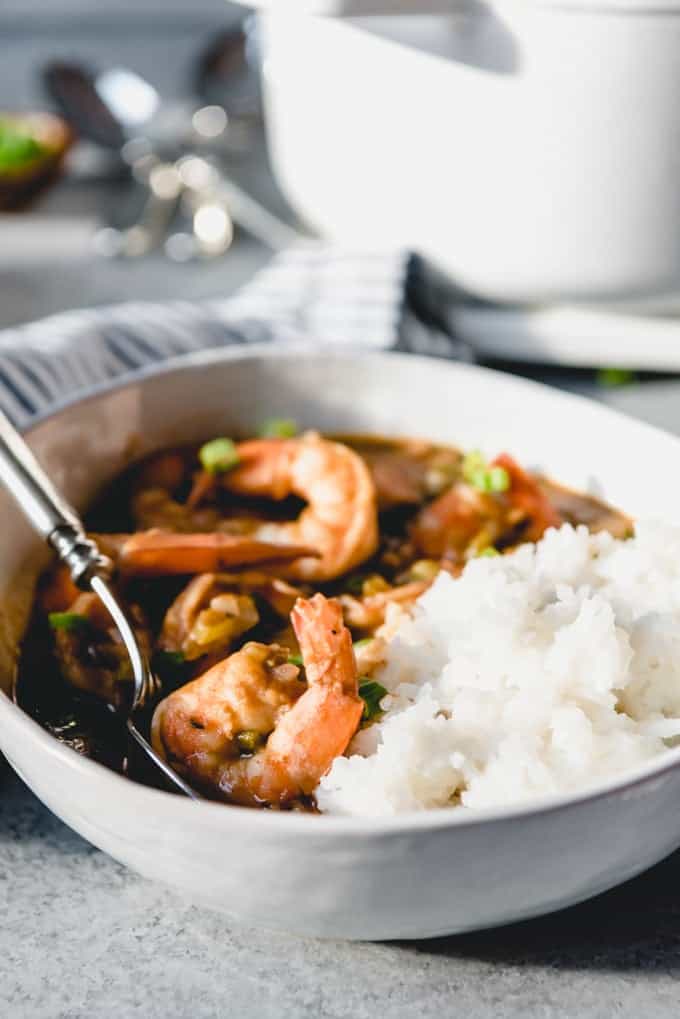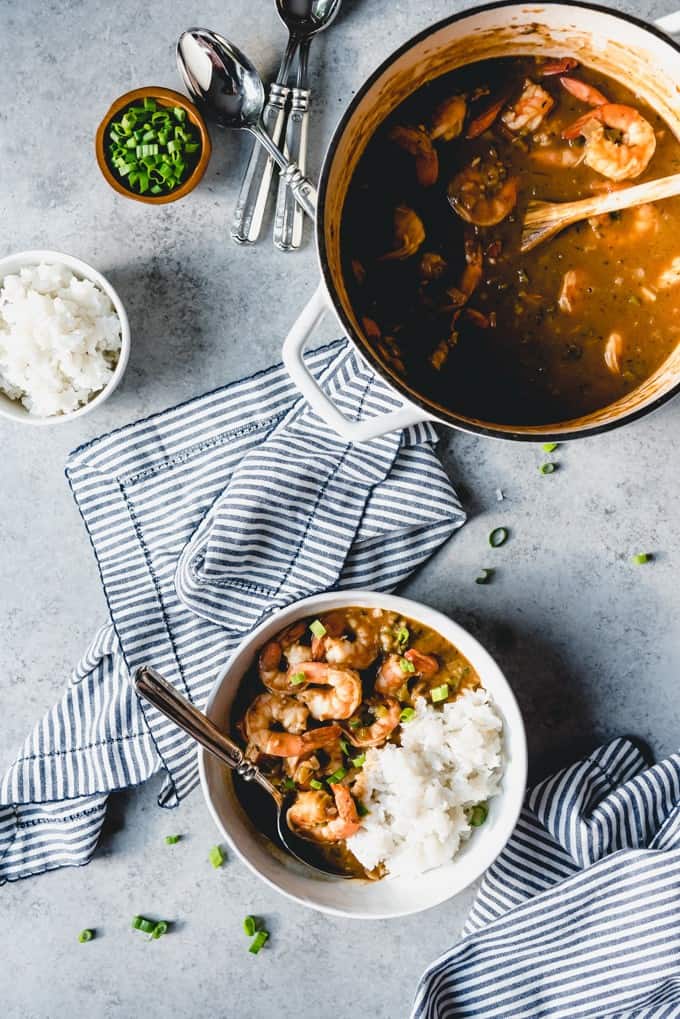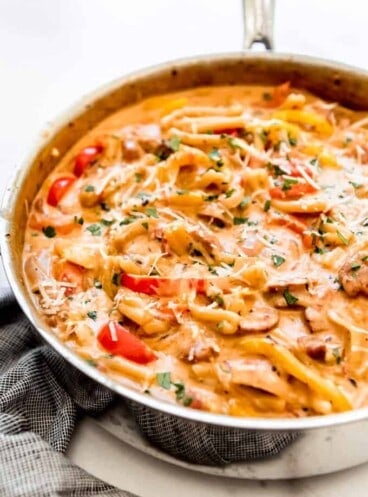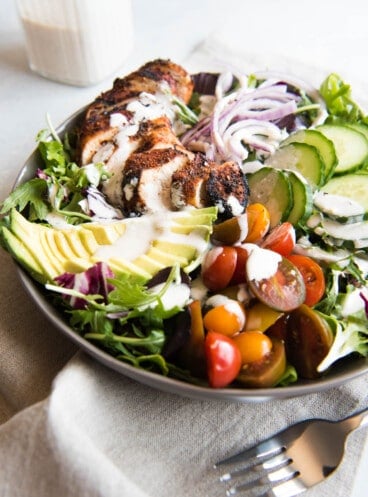You will love this Étouffée
I’m getting a little bit of a head start on Louisiana for my American Eats series with this delicious Shrimp Etouffee since Mardi Gras is coming up next week! For the most part I’m going in order, but every now and then a dish like this just won’t wait for me to get around to the state it belongs to!
What is Shrimp Etouffee?
If you have never heard of it before, shrimp étouffée (pronounced AY-too-FAY), is shrimp smothered in a rich gravy. Literally, the word étouffée is French for “smothered”. While I’m sharing a shrimp etouffee recipe here, it could be made with other shellfish instead, like crawfish or crab. Like many cajun recipes, the ingredient list is long and may look intimidating, but it’s actually quite a simple dish to make with a well-stocked spice cabinet. Unlike gumbo, which is more like a soup, shrimp etouffee is closer to a stew that is really delicious served over rice, which is traditional. We love shrimp dishes and make it all kinds of ways like Shrimp Po Boy Sandwiches, Creamy Garlic Shrimp Pasta, and Bang Bang Shrimp.
What is Cajun food?
I love Cajun food and it’s big, bold flavors. I think it commonly gets misunderstand for just being “spicy” but that’s not really an accurate depiction of what Cajun food is, even though yes, some Cajun cuisine is spicy, like the Cajun grilled chicken salad with creamy Cajun dressing that uses Cajun spices without being authentically Cajun. Instead, think of authentic Cajun food as more highly seasoned rather than just spicy hot. This shrimp etouffee, for example, is hardly spicy at all. Think of Cajun food as primarily comfort food created by French immigrants by way of Canada who lived out in the swamplands of Louisiana. They used primarily local ingredients to cook simple but delicious, majorly flavorful meals. Real Cajun food almost always includes the “holy trinity” of Cajun cooking – onions, celery, and bell pepper. It’s an adaptation of the f=/french cooking building block known as “mirepoix” – onions, celery, and carrots. Garlic, parsley, and green onions are also standard ingredients in most authentic Cajun cooking. Another staple of Cajun cooking is a “roux”. But while a French roux is made from butter and flour that are cooked together, Cajun roux is a bit different. It can be made with different fat sources, like vegetable oil, that allow the roux too be cooked longer and darker, obtaining a deep, totally unique flavor base for a dish. For my shrimp etouffee recipe, I make a dark brown roux with vegetable oil and flour that cooks slowly over anywhere from 22-27 minutes to develop a deep, amazing flavor for the sauce. You don’t have to make the dark brown roux if you are short on time. Many shrimp etouffee recipes call for a light or blond roux made by cooking the flour and oil for just 5 minutes, and it’s still an authentic etouffee. However, I think that might be more of a Creole version of etouffee rather than a Cajun one. I think that there might be some additional distinctions between Creole and Cajun versions of etouffee like the inclusion or exclusion of tomatoes and some slight seasoning differences. To be honest, I just don’t have enough background to distinguish between the two any more than I have already done. But I’m fairly certain that my version of shrimp etouffee with a dark brown roux is closer to Cajun than Creole, for what it’s worth. For a really great article about Cajun cuisine and some of the differences between Cajun and Creole cooking, this article is super interesting.
Shrimp Etouffee ingredients
Shrimp Vegetable Oil All-purpose Flour Onion Green Bell Pepper Celery Green Onions Garlic Chicken Broth Clam Juice Spices – Dried oregano, paprika, garlic powder, thyme, onion powder, black pepper, cayenne pepper, kosher salt, white pepper, and bay leaves make for a complex, deep flavor. Tabasco Sauce Salted Butter
How to make Dark Brown Roux for this Shrimp Etouffee
Since my knowledge of authentic Cajun cooking is limited, I relied on one of my favorite food blogs, Little Spice Jar, in creating my shrimp etouffee recipe. She gives a fantastic breakdown of the stages of making a roux for shrimp etouffee that I found super helpful. Essentially, to make a dark brown roux, you start by whisking flour into hot oil in a heavy bottom pot. Then it’s just a matter of stirring over medium to medium-high heat until you achieve the state of color and flavor you want for your shrimp etouffee. I’m obviously not from Louisiana, so take this with a huge grain of salt. But all my obsessive researching has led me to this conclusion. The thing to remember when making a dark brown roux is that it takes time and patience. You don’t want to stop stirring the roux or you run the risk of burning it. You can lower the heat from medium-high to medium if you feel like the roux is going through the stages too quickly. I know the effort it takes to make a dark brown roux isn’t for everyone, but I have to say that this dish, like bolognese sauce or risotto, two other classic dishes with some time requirements, is totally worth it. I actually find it fairly therapeutic to stir the roux and watch it go through it’s stages of flavor development. Aside from that, once you’ve made the roux, the hard part is done! All that is left is to saute the vegetables in the roux for about 5 minutes until they start to soften, adding the garlic right at the end.
How to Make Shrimp Etouffee
Etouffee Recipe variations
Spicy Shrimp Étouffée: Add extra Cajun seasoning, hot sauce, or diced jalapeños to give this dish a spicy kick. Seafood Étouffée: Rather than just use shrimp you can use a variety of seafood like crabmeat, crawfish tails, or even fish fillets along with the shrimp for a seafood medley. Smoked Sausage Étouffée: Add slices of smoked sausage or andouille sausage for added flavor and heartiness. Creamy Étouffée: Stir in a splash of heavy cream or coconut milk towards the end of cooking to create a creamy sauce (so good!).
Tips for this Seafood Etouffee Recipe
Use Fresh Ingredients: Opt for fresh or frozen shrimp and crisp vegetables to ensure the best flavor and texture in your dish. Prep Ingredients in Advance: Chop all vegetables and measure out spices before you start cooking to streamline the process. Cook the Roux Slowly: Take your time cooking the roux over low to medium heat to prevent it from burning. Stir continuously to avoid lumps. Add Aromatics: Sauté onions, celery, and bell peppers (the Cajun Trinity) until softened before adding other ingredients. This builds a flavorful base for the sauce. Use Cajun Seasoning: Cajun seasoning adds authentic flavor to shrimp étouffée. If you don’t have premade seasoning, you can make your own blend with spices like paprika, cayenne pepper, garlic powder, onion powder, and thyme. Simmer Slowly: Allow the sauce to simmer gently to allow the flavors to meld together and the sauce to thicken. This also helps the shrimp cook evenly without becoming tough.
How to serve Seafood Etoufee
Shrimp étouffée is traditionally served over cooked white rice. The rice helps soak up the flavorful sauce. Sprinkle chopped parsley or green onions over the finished dish before serving for a burst of freshness and color. You can plate the dishes for guests, or serve it family style, which is our preference, so everyone can dish their own taking as much rice, sauce, and shrimp as they like.
Storing Shrimp Etouffee
Leftover shrimp étouffée can be stored in an airtight container in the refrigerator for up to 3-4 days. For longer storage, you can freeze the leftover shrimp étouffée for up to 2-3 months. When reheating, make sure to heat the étouffée gently to prevent overcooking the shrimp and to maintain the flavors of the dish. I like to reheat leftovers on the stovetop over medium-low heat or in the microwave using short intervals while stirring occasionally to ensure even heating. If the sauce has thickened too much, you can add a splash of water or broth to loosen it up. If you are interested in celebrating Mardi Gras this year, keep scrolling past the recipe for even more recipes perfect for Fat Tuesday from some of my food blogging friends who I joined up with today to celebrate Carnival even though we aren’t in New Orleans!
More like this Etouffee Recipe
One Pot Creole-Style Jambalaya New Orleans-Style Cajun Chicken and Sausage Gumbo Instant Pot Red Beans & Rice New Orleans Beignets
More States I Have Visited in my American Eats Series
Alabama • Alaska • Arizona • Arkansas • California • Colorado • Connecticut • Delaware • Florida • Georgia • Hawaii • Idaho • Illinois • Indiana • Iowa • Kansas • Kentucky • Louisiana • Maine • Maryland • Massachusetts • Michigan • Minnesota • Mississippi • Missouri • Montana • Nebraska • New Jersey • New York • Oregon • Puerto Rico • South Carolina • South Dakota • Texas • Utah • Wisconsin
Mardi Gras King Cake
Cajun Pasta with Sausage and Peppers
Grilled Cajun Chicken Salad with Creamy Cajun Dressing
Let me know what you thought with a comment and rating below. You can also take a picture and tag me on Instagram @houseofnasheats or share it on the Pinterest pin so I can see.
